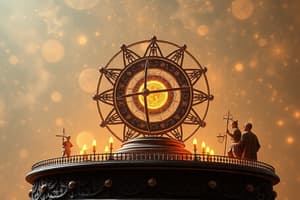Podcast
Questions and Answers
Which scientist proposed that atoms are indivisible particles that make up matter?
Which scientist proposed that atoms are indivisible particles that make up matter?
- John Dalton (correct)
- J.J. Thomson
- Ernest Rutherford
- Niels Bohr
According to John Dalton, atoms are characterized by being divisible and lacking perfect elasticity.
According to John Dalton, atoms are characterized by being divisible and lacking perfect elasticity.
False (B)
The term 'atom' was originally used to describe what?
The term 'atom' was originally used to describe what?
- Electrons revolving around a nucleus
- Indivisible particles that make up matter (correct)
- A nucleus with protons and neutrons
- A quantum mechanical model of the atom
Which scientist is credited with the discovery of the electron?
Which scientist is credited with the discovery of the electron?
Which atomic model proposed that electrons are embedded within a positively charged 'pudding'?
Which atomic model proposed that electrons are embedded within a positively charged 'pudding'?
Who proposed the nuclear model of the atom, which includes a central nucleus?
Who proposed the nuclear model of the atom, which includes a central nucleus?
Rutherford's gold foil experiment led to the discovery of which atomic component?
Rutherford's gold foil experiment led to the discovery of which atomic component?
What was the key finding from Rutherford’s gold foil experiment regarding the structure of an atom?
What was the key finding from Rutherford’s gold foil experiment regarding the structure of an atom?
How did Niels Bohr improve upon Rutherford's atomic model?
How did Niels Bohr improve upon Rutherford's atomic model?
What subatomic particle did James Chadwick discover?
What subatomic particle did James Chadwick discover?
John Dalton suggested that all matter is made up of tiny, indivisible particles called ________.
John Dalton suggested that all matter is made up of tiny, indivisible particles called ________.
J.J. Thomson discovered the ________, which led to the Plum Pudding Model.
J.J. Thomson discovered the ________, which led to the Plum Pudding Model.
Rutherford's gold foil experiment showed that atoms have a ________ at their center.
Rutherford's gold foil experiment showed that atoms have a ________ at their center.
According to Bohr's model, electrons move in fixed ________ around the nucleus.
According to Bohr's model, electrons move in fixed ________ around the nucleus.
James Chadwick is credited with discovering the ________, a neutrally charged particle found in the nucleus.
James Chadwick is credited with discovering the ________, a neutrally charged particle found in the nucleus.
Democritus developed the idea of atoms in 1808.
Democritus developed the idea of atoms in 1808.
What is the atomic number of an atom equivalent to?
What is the atomic number of an atom equivalent to?
What two types of particles are accounted for in the atomic mass of an atom?
What two types of particles are accounted for in the atomic mass of an atom?
Match the following atomic models with their key features:
Match the following atomic models with their key features:
The number of protons in an atom does not equal the number of electrons.
The number of protons in an atom does not equal the number of electrons.
Flashcards
Democritus' Atomic Idea
Democritus' Atomic Idea
The idea that all matter is composed of indivisible particles called 'atoma'.
John Dalton's Atomic Theory (1808)
John Dalton's Atomic Theory (1808)
Matter is made of tiny spheres with perfect elasticity.
J.J. Thomson's Discovery (1898)
J.J. Thomson's Discovery (1898)
Atoms can eject smaller, negative particles. This particle is called the Electron.
Plum Pudding Model (1904)
Plum Pudding Model (1904)
Signup and view all the flashcards
Rutherford's Gold Foil Experiment (1910)
Rutherford's Gold Foil Experiment (1910)
Signup and view all the flashcards
Bohr's Atomic Model (1913)
Bohr's Atomic Model (1913)
Signup and view all the flashcards
Neutron
Neutron
Signup and view all the flashcards
Atomic Number
Atomic Number
Signup and view all the flashcards
Atomic Mass
Atomic Mass
Signup and view all the flashcards
Electron Shells (Energy level)
Electron Shells (Energy level)
Signup and view all the flashcards
Study Notes
- At the end of this lesson, you should be able to describe the key historical models of the atom and explain how experimental evidence led to changes in atomic models over time.
- Key scientists to be aware of include Democritus, Dalton, Thomson, Rutherford, and Bohr.
- It's important to be able to demonstrate how scientific knowledge evolves based on new discoveries.
- "Thinking Flexibly" emphasizes the ability to change perspectives, consider new evidence, and adapt one's understanding.
- People believed everything was continuous and unbreakable thousands of years ago because they had no microscopes or modern technology.
- It can be hypothesized that materials are made of tiny building blocks that behave in predictable ways by experimenting and noticing patterns.
- By carefully observing everyday substances and their behaviors, it can be proven that things are made of tiny, invisible particles without modern technology.
History of the Atom Models
- Democritus developed the idea of atoms in 460 BC, calling the small particles "atoma" (Greek for indivisible).
- John Dalton suggested in 1808 that all matter was made up of tiny spheres with perfect elasticity, called atoms.
- Joseph John Thompson discovered in 1898 that atoms could eject smaller negative particles, called electrons.
- Thompson developed the Plum Pudding Model in 1904, suggesting atoms are made of electrons scattered in an elastic sphere of positive charge.
- Rutherford oversaw Geiger and Marsden's experiment in 1910, that fired Helium nuclei at gold foil, and discovered that only 1 in 10,000 hit.
- Rutherford's experiment involved firing fast-moving particles at a very thin gold foil, where most particles passed through, but about 1 in 8000 deflected.
- Rutherford proposed a more detailed model with a central nucleus, where the positive charge was concentrated, holding electrons in place by electrical attraction.
- Niels Bohr studied under Rutherford and refined his ideas in 1913 by adding that electrons were in orbits, like planets, with each orbit holding a set number of electrons.
- Alpha particles come from special materials like uranium and radium, can be fired with a machine using a particle accelerator, which speeds up helium nuclei and shoots them out.
- James Chadwick worked with Rutherford and Thompson, and proved in 1932 that neutrons exist.
Atomic Structure
- Electrons exist in Energy Levels or Shells around the nucleus.
- The electrons in the first shell limit the number to 2.
- The electrons in the second and third shell limit the number to 8.
Summary of Atomic Structure
- The Atomic Number of an atom = number of protons in the nucleus.
- The Atomic Mass of an atom = number of Protons + Neutrons in the nucleus.
- The number of Protons = Number of Electrons.
- Electrons orbit the nucleus in shells.
- Each shell can only carry a set number of electrons.
Studying That Suits You
Use AI to generate personalized quizzes and flashcards to suit your learning preferences.




